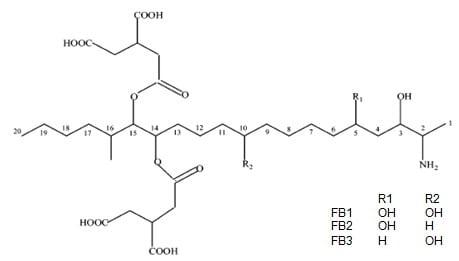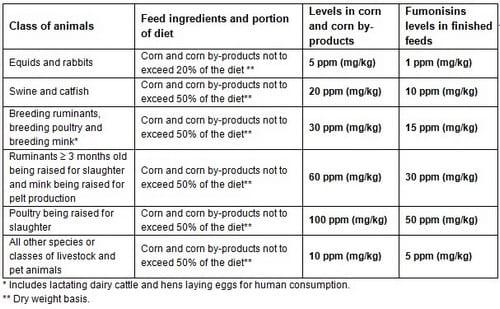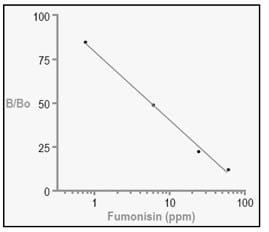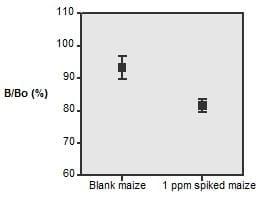Fumonisins Detection Method
Development and Validation of a Broad Dosage Range Enzyme Immunoassay for the Quantitative Determination of Total Fumonisins in Maize
Published: August 24, 2011
By: Giulia Rosar, Francesca Diana, Lidija Persic and Maurizio Paleologo (Tecna S.R.L)
A rapid and sensitive enzyme linked immunosorbent assay (ELISA) was developed for the quantitative detection of fumonisin B1, B2 and B3. The measuring range of this test is 0.75-60 ppm: this wide range makes the assay suitable for the analysis of samples for human nutrition as well as animal feeding according to the Food and Drug Administration guidelines and the European Regulation. The assay was validated on maize establishing the specificity, the sensitivity, the accuracy and the precision. The Limit of Detection (LOD) turned to be < 0.75 ppm, while the Limit of Quantification (LOQ) was found to be 1.00 ppm. Recoveries found for reference materials were meanly 117% while spiked maize samples gave 98% of recovery. Good correlation was achieved with HPLC analysis of incurred maize samples (r squared 0.9). Dosage intra- and inter-assay precision were establish to be lower than 5 and 15% respectively.
Introduction
Fumonisins are a group of mycotoxins primarily produced by Fusarium moniliforme (Dutton 1996, Nelson 1991). More than eleven structurally related fumonisins have been found since the discovery of fumonisin B1 (FB1) in 1988 (Gelderblom 1988). The fumonisin mycotoxins have been reported to be etiologic agents in leukoencephalomalacia in horses, pulmonary edema in swine, nephrotoxicity and liver cancer in rats, and esophageal cancer in humans (Marasas 1988, Rheeder 1992, Voss 1989). Because of the natural occurrence of FB1 and its analogs (structures in figure 1) in maize (Sydenham 1990) and their wide range of toxicological effects, it is essential to monitor human and animal exposure via foods. Analytical methods such as thin-layer chromatography, gas chromatography, high-performance liquid chromatography, liquid secondary - ion mass spectroscopy, gas chromatography - mass spectroscopy, ultra high-performance liquid chromatography tandem mass spectrometry have been applied to fumonisins but require extensive extraction, cleanup, and derivatization procedures (Rottinghaus 1992, Jackson 1990, Shephard 1990, Ono 2000, Ren 2011).
Immunoassays are an alternative to the above-mentioned analytical methods. Immunochemical methods for fumonisins using polyclonal or monoclonal antibodies have been developed in the past two decades because of their adaptability, easyness, speed, and low cost (Yu 1999, Hanne 2000, Savard 2004).
In this study, a rapid enzyme immunoassay for the quantitative determination of fumonisins in maize is presented.
The goal was to obtaine a suitable screening method for the detection of fumonisins within a broad range of dosage, thus covering the Food and Drug Administration and the EU regulatory limits for fumonisins in foods and feed (tables 1, 2, 3 and 4).

Figure 1. Chemical structures of fumonisins B1, B2 and B3.

Table 1. The FDA recommended limits for total fumonisins (FB1+FB2+FB3) in foods. FDA considers such levels achievable with the use of good agricultural and good manufacturing practices.

Table 2:. The FDA guidance levels for total fumonisins (FB1+ FB2 + FB3) in animal feed.

Table 3. European fumonisin limits of total fumonisins in cereals. Reference: Regulation (EC) 856/2005 of the commission, of 6 June 2005 amending the Regulation (EC) n. 466/2001; Regulation (EC) 1881/2006, of 19 December 2006 and its amendments: Regulation (EC) 1126/2007, of 28 September 2007

Table 4. European fumonisin limits of total fumonisins in cereals for anliamls. Reference: Recommendation 2006/576/CE of 17 August 2006
Materials and methods
Test principle:Celer FUMO is a direct competitive enzyme immunoassay. The assay is performed in plastic microwells that have been coated with anti-fumonisin antibody. In premixing wells an enzyme-labelled fumonisin and standard solutions (containing known concentrations of fumonisin B1) or samples are mixed and then transferred into the anti-fumonisin microtiter plate. During the first incubation, free fumonisin in the standard solution or in the sample and enzyme-labelled fumonisin compete for the anti-fumonisin antibody binding sites on the solid phase. Any unbound enzyme conjugate and fumonisin molecule is then removed within a washing step. The bound enzyme activity is determined by adding a fixed amount of a chromogenic substrate. The enzyme that is linked to the solid phase converts the colourless chromogen into a blue product. The addition of the stop reagent leads to a colour change from blue to yellow. The absorbance is measured with a microplate reader at 450 nm. The colour development is inversely proportional to the fumonisins concentration in the sample.
The polyclonal anti-fumonisins antibody was raised in rabbit by immunization with FB1-KLH, as previously reported (Fukuda 1994). The FB1-peroxidase conjugate was obtained according to Hermanson, 1996.
Assay time: 20 minutes.
Dosage range: 0.75-60 ppm.
Sample preparation: to 5 g of finely ground samples 1 g of NaCl and 25 ml of a solution of 70% methanol in distilled water are added. Samples are extracted by shaking thoroughly for 3 minutes and then filtered (Whatman n. 1). The filtrate is diluted 1:20 with distilled water.
Samples: 20 maize samples whose fumonisin content was less than 0.75 ppm (HPLC analysis) were used for Celer FUMO specificity determination. For the accuracy and precision study, different samples were tested: 2 maize Reference Materials supplied by FAPAS and Trilogy, 43 naturally contaminated HPLC analysed maize samples, and one blank maize sample spiked with fumonisin B1 in the range of 1-50 ppm.
Results and discussion
Immunoassay performance
An example of the calibration curve is shown in Figure 2. The tolerance range of the IC50 value (ppm corresponding to 50% of maximum absorbance signal inhibition) is 4-8 ppm, taking into account its variability (mean value ± 3 SD, n = 39).

Figure 2: Celer FUMO calibration curve (r = 0.998).
The cross-reactivity of the polyclonal antibody was determinated towards different fumonisins. Results are reported in table 5.

Table 5: Assay cross-reactivities set within four experiments (n = 4). For each fumonisin, mean cross-reactivity and standard deviation are minuted.
It is therefore notable that Celer FUMO has almost the same affinity for all the three main fumonisins.
Maize validation
Specificity
The specificity of the assay was studied by analysing 20 blank maize samples. Since no determination turned to be positive, the specificity was 100%. The Limit of Detection (LOD), calculated as the mean value of B/Bo - 2SD of the blank samples, was < 0.75 ppm.
Sensitivity
The same blank samples were spiked at 1 ppm of FB1. All determinations turned to be positive by the assay, with no false compliant results. The sensitivity of the assay was therefore 100%. These data indicate that the Limit of Quantification (LOQ) is £ 1 ppm.
The mean concentration value of 1 ppm spiked maize samples was 1.02 ± 0.20 ppm.
The B/Bo (%) values in terms of blank and LOQ spiked samples are compared in the graph in figure 3.

Figure 3: Celer FUMO specificity and sensitivity graph. Mean inhibition and standard deviations of blank and LOQ spiked samples are represented by symbols and whiskers. (n = 20 determinations each dataset).
Trueness
Two reference materials were used during Celer FUMO validation, one was supplied by FAPAS and one by Trilogy. They were analysed within nine replicates each. FAPAS T2228, expected to have 3.0 ppm of fumonisins, was 3.6 ppm by the ELISA kit (118% recovery). Trilogy F5 maize, expected to be 5.9 ppm, was 6.9 ppm by the kit (116% recovery). The mean recovery was therefore 117%.
The performances of Celer FUMO were evaluated time by time by partecipating to proficiency tests, as minuted in the table 6. All results were satisfactory, and achieved Z-scored were always < |1|.

Table 6: Results obtained within the participation of different ring tests with both blank and contaminated maize samples
Celer FUMO performances were evaluated in an inter-laboratory study organized by the Italian Istituto Superiore di Sanità, where 14 partecipants were required to analyse by Celer and by a competitor test kit five fumonisin incurred samples (Brera 2008). The table 7 reports the performances obtained in the above-mentioned trial.

Table 7: Results obtained by fourteen different laboratories participating to the trial (Brera 2008).
Accuracy
Besides reference materials, recoveries were studied by spiking one blank maize sample at different levels, in order to cover all the dosage range of the assay (1 - 50 ppm). The mean recovery found for n = 56 determinations was 98 ± 11%, considered compliant to all screening requirements. Bias was also evaluated by testing 60 different incurred maize samples. They were both analysed in HPLC by an external laboratory and with Celer FUMO within the in-house validation. The linear correlation between the performances of the two methods gave an R squared value of 0.9 and a coefficient of 1.1. The mean recovery was 110±30%.
Precision
The precision of Celer FUMO was calculated as the Coefficient of Variation (CV%) of the results obtained for 9 naturally contaminated maize samples and 6 spiking levels (Table 8). The mean intra-assay CV% (n = 3 determinations for each sample) was 4.0 for incurred samples and 5.4 for the spiked ones. The inter-assay CVs% (n = 3 different experiments) were 10.5 and 12.6, respectively.

Table 8: Intra- and inter-assay CV (%) obtained by analysing incurred and spiked samples within the same assay and in different experiments.
Conclusions
The obtained validation results show that Celer FUMO can be used as a specific, precise and accurate screening method for the quantitative detection of fumonisins in maize. Recovery data indicate that the accuracy of the assay is high and constant along its entire dosage range; it is therefore suitable also for the analysis of highly contaminated samples, in compliance with FDA and the EU limits.
Additional advantages of this assay are quickness (only twenty minutes, apart from sample preparation), easiness to use and a measuring range much wider what achievable by the other commercailly available kits .
References
Dutton, M. F. Fumonisins, mycotoxins of increasing importance: their nature and their effects. Pharmacol. Ther. 1996, 70, 137-161.
Nelson, P. E.; Plattner, R. D.; Shackelford, D. D.; Desjardins, A. E. Production of fumonisins by Fusarium moniliforme strains from various substrates and geographic areas. Appl. EnViron. Microbiol. 1991, 57, 2410-2412.
Gelderblom, W. C. A.; Jasiewicz, K.; Marasas, W. F. O.; Thiel, P. G.; Horak, R. M.; Vleggar, R.; Kriek, N. P. J. Fumonisins novel mycotoxins with cancer-promoting activity produced by Fusarium moniliforme. Appl. EnViron. Microbiol. 1988, 54, 1806-1811.
Marasas, W.F.; Kellerman, T.S.; Gelderblom, W.C.A.; Coetzer, J.A.; Thie,l P.G.; van der Lugt, J.J. Leukoencephalomalacia in a horse induced by fumonisin B1 isolated from Fusarium moniliforme. J Vet Res. 1988, 55, 197-203
Rheeder, J.P.; Marasas, W. F. O.; Thiel, P. G.; Sydenham, E. W.; Shephard, G. S.; Van Schalkwyk, D. J. Fusarium moniliforme and fumonisins in corn in relation to human esophageal cancer in Transkei. Phytopathology 1992, 82, 353-357.
Voss, K.A.; Norred, W.P.; Plattner, R.D.; Bacon, C.W. Hepatotoxicity and renal toxicity in rats of corn samples associated with field cases of equine leukoencephalomalacia. Food Chem Toxicol. 1989, 27, 89-96.
Sydenham, E. W.; Gelderblom W. C. A.; Thiel P. G.; Marasas W.F. Evidence for the natural occurrence of fumonisin B1, a mycotoxin produced by Futsariurn moniliforme, in corn. J. Agric. Food Chem. 1990, 38, 285-290.
Rottinghaus, G.E.; Coatney, C.E., Minor, H.C. A Rapid, Sensitive Thin Layer Chromatography Procedure for the Detection of Fumonisin B1 and B2. J. Vet. Diag. Inv. 1992, 4, 326-329
Jackson, M.A.; Bennett G.A. Production of fumonisin B1 by Fusarium moniliforme NRRL 13616 in submerged culture. Appl. Environ. Microbiol. 1990, 56, 2296-2298
Shephard, G. S.; Sydenham, E. W.; Thiel, P. G.; Gelderblom, W. C. A. Quantitative determination of fumonisins B1 and B2 by high-performance liquid chromatography with fluorescence detection. Journ. Liq. Chrom. 1990, 13, 2077-2087
Ono, E. Y. S.; Kawamura, O.; Ono, M. A.; Ueno, Y.; Hirooka, E. Y. A Comparative Study of Indirect Competitive ELISA and HPLC for Fumonisin Detection in Corn of the State of Parana, Brazil. Food Agric Immunol, 2000, 12, 5-14
Ren, Y.; Zhang, Y.; Han, S.; Han, Z.; Wu, Y. Simultaneous determination of fumonisins B1, B2 and B3 contaminants in maize by ultra high-performance liquid chromatography tandem mass spectrometry. Anal Chim Acta 2011,692, 138-45
Yu, F. Y.; Chu, F. S. Production and characterization of a monoclonal anti-anti-idiotype antibody against fumonisin B1. J. Agric. Food Chem. 1999, 47, 4815-4820
Hanne, R. C.; Yu, F. Y.; Chu, F. S. Development of a polyclonal antibody-based sensitive enzyme-linked immunosorbent assay for fumonisin B4. J. Agric. Food Chem. 2000, 48, 1977-1984.
Savard, M. E.; Sinha, R. C.; Lau, R.; Seguin, C.; Buffam, S. Monoclonal antibodies for fumonisins B1, B2 and B3. Food Agric. Immunol. 2004, 15, 127-134.
Fukuda, S.; Nagahara, A.; Kikuchi, M.; Kumagai, S. Preparation and characterization of anti-fumonisin monoclonal antibodies. Biosc. Biotech. Biochem. 1994, 58, 765-767.
Hermanson, G.T. Bioconjugate techniques, 1996 ed. Academic Press, ch. 3, 475-476.
Brera, C.; Debegnach, F.; Da Santis, B.; Pannuzzi, E.; Berdini, C.; Prantera, E.; Miraglia, M. Validazione di metodi immunoenzimatici per la determinazione delle micotossine in campioni di cereali. I Georgofili. Quaderni 2008 - IV, ed Polistampa, 33-45.
Related topics:
Authors:
Tecna SRL
Recommend
Comment
Share
Tecna SRL
18 de octubre de 2011
Dear Professor,
I would like to thank you for visiting Tecna's showcase and reading our technical article. We appreciated your interest and we will be glad to provide you all the necessary informations.
My colleagues of the Sales Department will contact you soon.
Yours sincerely,
Giulia Rosar
Tecna s.r.l.
Padriciano 99, 34149 I-Italy
+390403755341
www.tecnalab.com
Recommend
Reply
15 de octubre de 2011
Congratulations to Rosar et., al for this breakthrough. Is the kit now available in the market for researchers use
in the developing nations? How can I get a sample for my postgraduate students working on fumonisins in grains?
Prof. Afolabi Oluwadun
College of Health Sciences
Olabisi Onabanjo University
P.O.Box 567
Sagamu
Ogun State, NIGERIA. Tel.+2348033871945. E-mail: afolabioluwadun@yahoo.com
Recommend
Reply
15 de octubre de 2011
Congratulations to Rosar et., al for this breakthrough. Is the kit now available in the market for researchers use
in the developing nations? How can I get a sample for my postgraduate students working on fumonisins in grains?
Prof. Afolabi Oluwadun
College of Health Sciences
Olabisi Onabanjo University
P.O.Box 567
Sagamu
Ogun State, NIGERIA. Tel.+2348033871945
NIGERIA
T
Recommend
Reply

Would you like to discuss another topic? Create a new post to engage with experts in the community.







.jpg&w=3840&q=75)